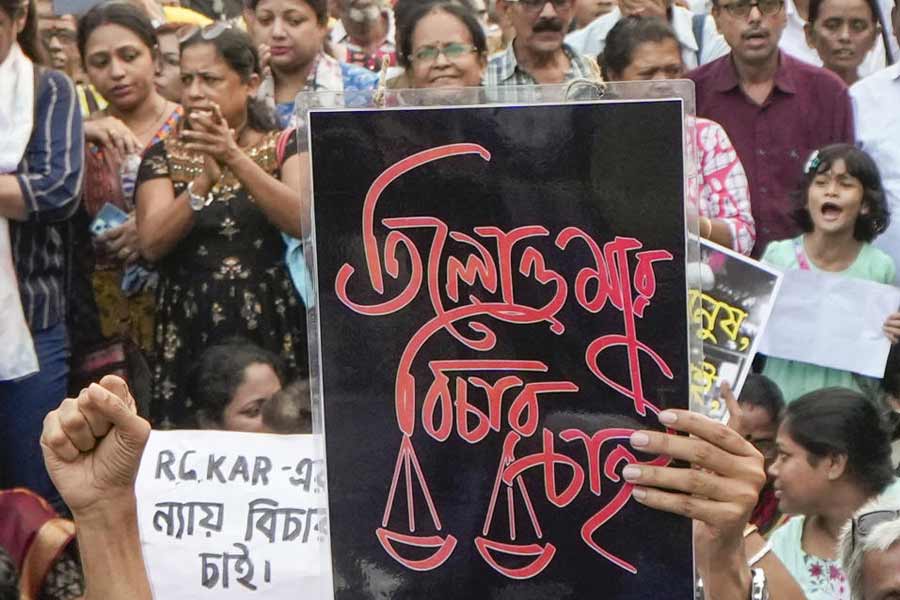.jpg) | .jpg) |
| Gurer Rasogolla at Bhikharam | Gajar ka Halwa at Kalpataru. |
Pictures by Sanat Kumar Sinha | |
It’s next to impossible to walk past a sweet shop in winter and not peep in. And once you’ve surveyed the Kachagolla and Jolbhora at a Bengali sweet shop or the Gajar ka Halwa at the local halwai’s, it’s even tougher to resist them.
“I cross Kwality More for my fashion designing classes four times a week and since the onset of winter I’ve been stopping at Sen Mahasay every day on the way back,” confessed Suchanda Konar of New Town, biting into a juicy Gurer Rosogolla at the shop and packing some to take home. On her take-away list was Gurer Kaju Barfi, a north Indian dessert with a local touch which the shop has added to its inventory of traditional Bengal sweets in recent years.
Earlier each sweet shop stuck to its forte — chhana-based sweets at Bengali shops and kheer or besan-based sweets for north Indian shops — the inclination to experiment among buyers has triggered cross-overs, thus making them diversify their product range beyond their core competence area. The trend is most noticeable in winter when the availability of jaggery jacks up demand for Bengali sweets while Gajar ka Halwa becomes a must-taste for buyers of all inclinations.
Just jaggery
“Our sales double in winter,” smiles Gurupada Chakrabarti of CF Block’s Makhan Lal Das & Sons. “Even people who are calorie-conscious all year seem to drop their guard this season. The credit goes to jaggery.”
Ashok Kumar Maity of Sen Mahasay can hardly decide which his most popular winter item is. “Kachagolla, Monohara, Rosogolla… anything with jaggery is a winner. Even experimental items like Gurer Butterscotch and Gurer Kaju Barfi are sell-outs,” says Maity, busy packing massive Gurer Sandeshes on a wedding gift tray (tattwa). “These sandeshes are Rs 30 a piece. There are lots of orders for tattwa and from caterers this season and everyone insists on gur items.”
AE Block’s Annapurna Sweets has a catalogue on tattwa designs with bride and groom dolls, fruits and vegetables — all made out of Gurer Sandesh. “Ninety per cent of our sweets use gur instead of sugar in winter,” says Badal Palit, pointing at Gurer Rosomalai, Gurer Doodh Puli, Gurer Rajbhog and Gurer Bati.
For diabetics, Amantran in Purbachal Market makes Kachagollas as taste-neutral as possible. “It has minimum jaggery so diabetics can pop in one without harming their health,” says owner Paritosh Ghosh.
It’s not just sweets made of jaggery but jaggery itself that customers have their eyes on. “I’ve bought a jar of nolen gur so my wife can add small quantities of it in her cooking around the year,” says Saradindu Bose, a blood sugar patient of Karunamoyee who was seen buying Gurer Sandesh at Makhan Lal on Monday. The salesperson, Chakrabarti, adds that their previous stock of nolen gur jars vanished and customers hounded him till fresh stocks arrived.
Even if jaggery is not used to make Rajasthani sweets, the ingredient is added to Bajra Roti, a winter speciality. “Gur ka Chawal is feasted upon in winter weddings,” says Manju Baid of BE Block. But such items are made mostly at home. So for a ready-made taste of jaggery in winter, even for non-Bengalis, it is over to Gurer Sandesh and Rasogolla.
Cross-over culture
Not wanting to miss out on customer demand, some north-Indian sweet shops are keeping Bengali sweets, even if just the basic items.
That Bengali sweets are very popular among other communities can be gauged from the fact that the ladies wing of Bidhannagar Maheshwari Sabha recently held a Sandesh-making workshop for its members.
Member Kavita Somani taught the 70-strong gathering to make winter desserts like kada paker sandesh and kachagolla with nolen gur. “I love gur sweets and have been making these dishes at home for more than 25 years,” says Somani, a resident of Purbachal.
Says Mala Maheshwari, a member of the workshop’s organising committee: “I love jaggery and eat kachagolla daily. I find Bengali sweets to be lighter and easier to digest than our sweets that use ghee.”
“Rajasthani sweets are mostly kheer-based and the set-up for this is different from Bengali sweets that are chhana-based,” says a sales representative of Haldiram’s Prabhuji. “But in winter we are forced to keep at least Gurer Sandesh and Gurer Rasogolla as even our regular clientele, who do not ask for Bengali sweets round the year, demand these.”
The cross-over is not a one-way traffic. Bengalis too like Kheer Malai and Badam Barfi, says the Haldiram’s representative.
Mahesh Sureka of Bhikharam, next to City Centre, says Bengalis are eager to try new dishes. “The finni — a reed-thin flour-and-sugar item — looks nothing like any Bengali dish but I’ve seen Bengalis inspecting it curiously and then taking home boxes to try out,” he says. “Besides, I get more Bengali customers in this outlet than people from any other community.”
Purbachal’s Amantran has started keeping Gajar ka Halwa and Dhoklas alongside Gurer Kolshi and Gurer Ghot. “Bengali sweets is our primary revenue generator. But by introducing a Gajar ka Halwa we are increasing our customer base. Plus, the dish is popular among people of all communities,” says Ghosh.
Palit of Annapurna has noticed an increasing trend of non-Bengalis flocking to Bengali sweets. “But they prefer lighter, less sweet items like Gurer Sandesh and Kachagolla,” he says.
 |
| Gurer kada paker sandesh at Amantran in Purbachal Market. Pictures by Sanat Kumar Sinha |
Kalpataru, the popular confectioner in CA Market, has been stocking a few north-Indian items like Son Papdi and Kaju Barfi since its inception 10 years ago. “That’s because our immediate neighbourhood has a lot of north Indians. We have added kheer-stuffed Potol, Kheer Kaju Roll and Gajar ka Halwa in recent years. Moreover, the number of Bengalis refusing to taste other kinds of sweets has dwindled to one in 10,” says Prosenjit Sil, the young proprietor.
To cater to north Indian communities, the shop has started making Chamcham, Rajbhog and Rasmalai using kesar. “While kheer or malai chamcham are preferred by Bengalis, north Indians prefer kesar-laced yellow varieties. Round the year, we keep both varieties except in winter when gur rules,” Sil says. “They take a leaf out of our book, we take a leaf out of theirs. No shop wants to lose out on customers,” he smiles.
North-Indian niceties
If Bengali confectioneries are playing the jaggery card, north indian sweet shops are churning out mawa (a form of condensed milk) and kheer-based items. “Jaggery doesn’t blend easily with Rajasthani sweets so we cannot make use of its availability this season,” says Sureka of Bhikharam. “But we bring experts from Rajasthan every winter to make traditional sweets.”
These sweets include Ghewar, a deep, round-shaped honeycomb-like desert made of flour and fried in ghee. Finni is a sweet made of kesar which looks like yellow strands and Til ka Gajak is a crispy bite made of sesame. “These are eaten especially on Makar Sankranti,” adds Sureka.
Haldiram’s Prabhuji in Ultadanga banks on Moti Pak, a sweet made of besan, and Sharma Tea near the swimming pool is selling Gulab Jamun by the dozen and Gajar ka Halwa by the kilo. “These are our two winter specialities. We’re selling 15 to 20 kg of halwa a day,” says Brijesh Sharma.
Non-Bengali sweet shops also rely heavily on cashew and almonds as an ingredient. Bhikharam has an unending variety — Kaju Pan, Kaju Suraj, Kaju Sandwich, Kaju Tarbooj, Badam Phul, Badam Butterscotch, Badam Pista Barfi…. Haldiram’s Prabhuji says Badam Barfi is their undisputed top seller, followed by Son Papdi. Ask for them at your local sweet shop and wait till you see some stocked next to sandesh and rasogolla soon.
Til Papdi
 |
(Mayukh Sengupta) |
Ingredients
- Roasted sesame seeds (til) - ½ cup
- Sugar ½ cup
- Pistachio (chopped
- - ½ tsp
- Ghee - a little
Method
Melt the sugar by heating. Do not add any water. Add the sesame seeds to it and mix well. Now put the sesame seeds on a wooden chaki that has been smeared with ghee. Add the pistachios to it and quickly flatten it out like a roti. Immediately use a knife to scrape it off. Otherwise, the sesame seeds will stick to the chaki.
Contributed by Kavita Somani, a resident of Purbachal, who conducted a workshop on desserts for Bidhannagar Maheshwari Sabha recently
Input from Sudeshna Banerjee










